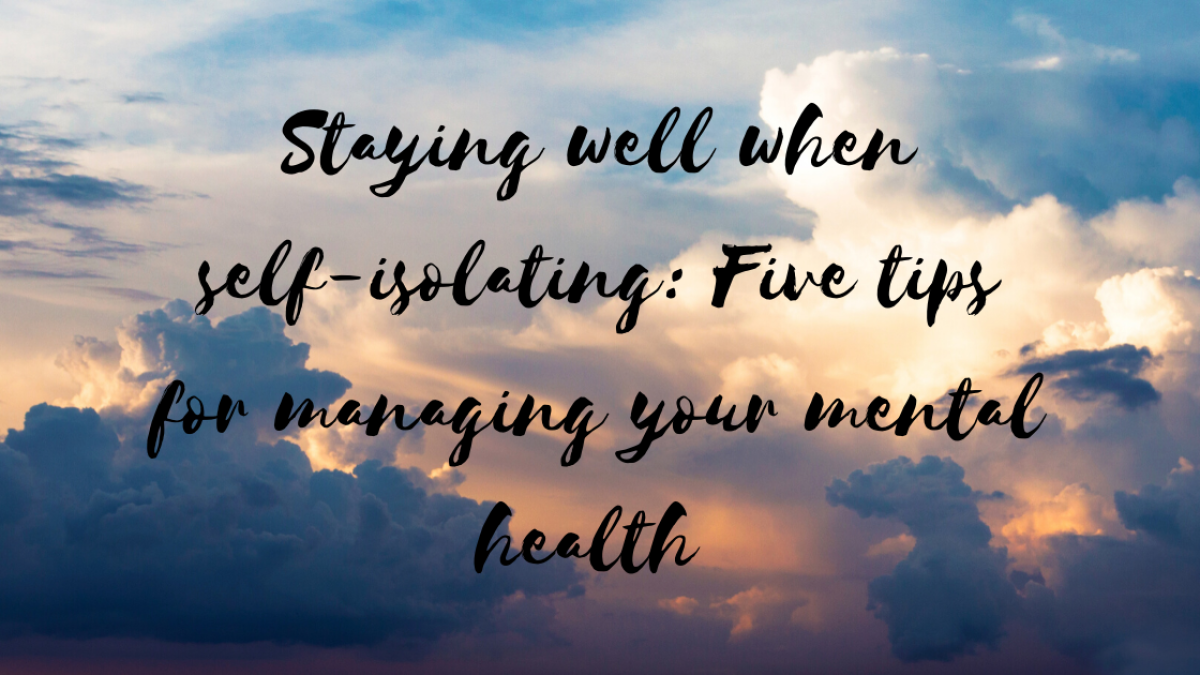
Staying Well When Self-Isolating: five tips for managing your mental health
In the last few weeks ‘self-isolating’ is a term that has gone from an abstract, seldom heard phrase to a very real possibility. As we all work together to try to contain the spread of Coronavirus (Covid-19), self-isolating has become an important tool in helping reduce the impact of the virus. But what about if you do need to self-isolate? Two weeks on your own can suddenly feel like a very long time, and with anxieties already high, how can you look after your mental health? We have five tips for you to help manage your mental health if you do have to self-isolate.
Keep Active
Depending on where you live – and who you live with – the space you have while self-isolating will vary. You might have your usual living space, or you could be stuck in one room. Either way, keeping physically active is important. Of course if you start to experience symptoms and feel unwell, managing your physical health is most important and rest is key to recovery, but keeping mobile plays an important part in staying well. In fact, research shows that exercise can help improve symptoms of a number of mental health disorders (such as depression and anxiety), can improve cognitive functioning, and your general well-being (Czosnek et al., 2019; Parker et al., 2016). That means it’s as important to remember to exercise at times of stress as it is at times you are well.
How do you normally like to exercise when at home? Do you do yoga, exercise DVDs, walking? World Health Organisation information advises not being in direct contact with others, or within two metres, but that means you can still walk around your garden if you have access to one (remembering to take sensible precautions with others’ safety). If you are self-isolating within one room, even basic bodyweight exercise (press ups, sit ups, plank) can help get you active enough for your body to produce endorphins, the hormones that help to boost your mood after exercise. Some light exercise is also important for reducing boredom, helping to keep a sense of routine, and for keeping your body moving. At the very least, getting up for a few minutes every half an hour can help loosen off stiff muscles and, evidence suggests, help keep you well throughout life, not just in self-isolation! (Diaz et al., 2017).
Keep in touch
Physical self-isolation doesn’t have to mean completely shutting yourself off from the world for two weeks. While a video call, webchat, or messaging doesn’t feel quite the same as chatting in person, keeping in touch with friends and family while self-isolating is really important. We know that social contact is highly beneficial for your mental health (Rubin et al., 2016; Sani et al., 2012), and isolation has been identified as a key contributing factor to depression, physical inactivity, and poorer self-rated health (Hämmig, 2019).
It’s likely when you first self-isolate your phone will be busy with people responding to your messages telling them you’re in isolation, but that will taper off and so it’s important to make an effort to keep in touch with people. Aim for a phone or video call once a day. Use it as an opportunity to catch up with friends or family you’ve been meaning to speak to for a while but haven’t gotten around to it. Connect with interest groups on social media or forums. The key thing is to ensure self-isolation doesn’t equate with social isolation. That regular contact will help you feel less alone in what you’re going through. It doesn’t have to be for long, but it’s important to make this a priority in your day.
Keep doing things you enjoy
In therapeutic terms, doing things you enjoy – or what we might call Behavioural Activation – is an essential component of treatment in improving mental health. It’s equally important for staying well. There are a number of reasons why doing things you enjoy improve your mood, and most are linked with the sense of reward and positive emotion from engaging in a task you enjoy, as well as the benefits of focusing your mind on the task at hand (Hoyer et al., 2020).
Most people enjoy at least some form of sedentary activity, such as watching shows on TV or streaming sites, reading or gaming, but it’s important to try and balance these with something that has a tangible outcome. That’s why crafts, tinkering, building or gardening are really useful to mix in – the sense of accomplishment and achievement from seeing the outcome of your work (purposeful activity) is a big boost for mental health (Coventry et al., 2019). Never tried your hand at making something? Now is a good time to learn! The internet hosts so many excellent instructional videos to help you develop your skills. Why not mix in something new with other activities you enjoy? Having a variety of activities to engage in helps to relieve boredom and gives your mental health a boost.
Keep calm
Worry and stress are natural responses to situations we perceive as concerning or dangerous. At the moment, many people are worried about how Covid-19 is going to impact them. A little bit of stress is not a bad thing – this is what prompts us to pay attention to good advice (wash your hands!) and take appropriate precautions to protect our health and the health of others. However, too much stress can have a detrimental effect on both your body and your mind. So how can you keep calm while self-isolating?
Physical activity, social contact, and keeping busy, as discussed above, are key elements in staying calm. If you feel you don’t want or feel unable to share with friends or family how you’re feeling, you can call Samaritans for free from any phone on 116 123 to get support from someone trained to listen and help you. There are other effective strategies you can use to cope with peaks of stress or anxiety, too.
How do I do that?
One of our favourite exercises for helping you regain calm is a counted breathing exercise. Breathe in for four and out for four (remembering to count slowly!), inhaling and exhaling for the whole count. Imagine you have a balloon in your stomach that you are trying to fill with each breath – this encourages your diaphragm to expand to help get a full, deep breath. Exhale as much of the breath as possible in the count of four. By slowing down your breathing you use your biology to help you; everything else has to slow down too. Just 90-120 seconds of this (about 9-12 breaths depending on how fast you count) is enough to feel yourself calming down.
Another really useful exercise is grounding – the process of bringing your mind back from its quickly-escalating worries to the here-and-now. There are lots of different ways to do this, but here are two of our favourites. First, use colour. Find five red things in your room. Then five orange things. Then five yellow, five green, five blue. Work through the rainbow. This distracts you from the worries that are exacerbating your stress and connects you with what’s going on around you. Another exercise is playing ‘I Spy’, working through letters of the alphabet. Find something in your room that begins with A. Then B, C, D, and so on. Before you reach the end of the alphabet you’re likely to have found yourself feeling more calm and relaxed again. Once you feel more settled, use one of the above strategies (call someone, do something you enjoy, or move your body) to continue to restore your feeling of calm.
Keep challenging unhelpful thoughts
Whenever we are worried, it’s easy to slip into habits of unhelpful thinking. We all do this from time-to-time, but unhelpful thinking styles don’t help us to problem solve or cope with what we’re facing – instead they just leave us feeling worse. Common types of unhelpful thinking include catastrophising (imagining the worst), all-or-nothing thinking, or having a mental filter – where we focus on negative parts of a situation at the expense of any positives. In the case of self-isolation, these thoughts might look like “I’m going to be stuck here forever, I’m never going to get better”, or “This is awful, I just have to watch and wait to get ill.”
So what do you do about these unhelpful thoughts? The first step is being aware of them. Have you noticed your worry or stress increasing? What’s going through your head? Identifying the thought is the first step to challenging it. Often, an unhelpful thought elicits a strong negative emotion. Let’s take the example of being stuck in self-isolation forever. We can expect that thought might produce a lot of worry and distress. When challenging thoughts it can be useful to write things down; it helps you to focus on the thought and challenge it more effectively.
How do I do that?
First things first – how much do you believe the truth of that thought? It can be useful to rate this on a scale of 0-100%. What emotions does the thought make you experience? Now you can challenge the thought. One way to do this is to consider the evidence for and against the thought – this allows you to examine the thought from a more objective stance. What is the evidence for the thought? “Sometimes people have to self-isolate for more than two weeks. Some people have got really ill or even died.” Okay, it’s easy to see why that would make you feel anxious! What is the evidence against the thought? “Even if people have to stay in self-isolation for longer, it’s only for another week or so, or while they get treatment. The vast majority of people completely recover.” Now re-examine your original thought. Re-rate how much you believe it now you’ve considered evidence for and against it. Once we’ve considered evidence that challenges our initial thought, that helps us re-evaluate it and see where that thought might have been unhelpful.
Do you have other tips you’d like to share? Let us know!
References
Coventry, P. A., Neale, C., Dyke, A., Pateman, R., & Cinderby, S. (2019). The Mental Health Benefits of Purposeful Activities in Public Green Spaces in Urban and Semi-Urban Neighbourhoods: A Mixed-Methods Pilot and Proof of Concept Study. International Journal of Environmental Research and Public Health, 16(15), 2712.
Czosnek, L., Lederman, O., Cormie, P., Zopf, E., Stubbs, B., & Rosenbaum, S. (2019). Health benefits, safety and cost of physical activity interventions for mental health conditions: A meta-review to inform translation efforts. Mental Health and Physical Activity, 16, 140-151.
Diaz, K. M., Howard, V. J., Hutto, B., Colabianchi, N., Vena, J. E., Safford, M. M., … & Hooker, S. P. (2017). Patterns of Sedentary Behavior and Mortality in U.S. Middle-Aged and Older Adults: A National Cohort Study. Annals of Internal Medicine, 167(7), 465-475.
Hämmig, O. (2019). Health risks associated with social isolation in general and in young, middle and old age. PLoS ONE, 14(7), e0219663.
Parker, A. G., Hetrick, S. E., Jorm., A. F., Mackinnon, A. J., McGorry, P. D., … & Purcell, R. (2016). The effectiveness of simple psychological and physical activity interventions for high prevalence mental health problems in young people: A factorial randomised controlled trial. Journal of Affective Disorders, 196, 200-209.
Rubin, M., Evans, O., & Wilkinson, R. B. (2016). A Longitudinal Study of the Relations Among University Students’ Subjective Social Status, Social Contact with University Friends, and Mental Health and Well-Being. Journal of Social and Clinical Psychology, 35(9), 722-737.
Sani, F., Herrera, M., Boroch, O., & Gulyas, C. (2012). Comparing social contact and group identification as predictors of mental health. British Journal of Social Psychology, 51(4), 781-790.


